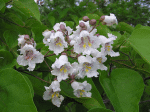Specifications:
Hull wood
Displacement 191 tons
Length 105' 2"
Beam 22' 2"
Draft 7' 2"
Speed 10 knots
Complement 37
Armament two 24-pdr, one heavy 12-pdr smoothbore
Propulsion one vertical direct-acting condensing engine (34" x 30"), one screw
| Commanding Officers | ||
| 01 | Acting Ensign John A. Edgren | 12 July 1864 - ???? |
Catalpa
DANFS history entry located at the Naval History and Heritage Command website
Additional Resources and Web Sites of Interest
National Association of Fleet Tug Sailors
| Back to the Navsource Photo Archives Main Page | Back To The Yard and District Craft Photo Index | Back To The District Harbor Tug (YT) Photo Index |
| Comments, Suggestions, E-mail Webmaster. |
|
This page was created and is maintained by David L. Wright |
